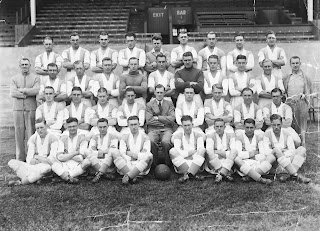Jordan Shipley's superb finish for City's goal against Swansea on Tuesday night ensured he joined an elite group of players to have scored in three different divisions for the club. The Leamington lad 's instinctive shot went in off the post to give the Sky Blues an early lead which was later pegged back by Andre Ayew, reputedly one of the highest paid players in the Championship.
Jordan, by my reckoning, became the twelfth City player to achieve the feat including some who scored goals in the old regional Third Divisions which preceded Divisions Three and Four before 1958. The first to achieve it was Fred 'Cute' Herbert who netted in Division Two in 1924-25, in Division Three North in 1925-26 and in Three South in 1926-27 when the club was switched that season. Coventrian Herbert was a one-club man who scored 86 goals in 199 league and cup games between 1922-29.
Ray Straw, was another prolific centre-forward who netted 74 goals in Division Three South, Four and Three between 1957-1961. Ronnie Farmer scored goals in Divisions Four, Three and Two between 1958-1967. Brian Hill only managed seven league goals in 284 games but managed to score in Division Three South in 1957-58 as well as Divisions Three and One, the latter a stunning goal at Fulham in 1968.
Hill was one of several players who achieved the feat during City's rise through the divisions under Jimmy Hill including George Curtis, Mick Kearns, Dietmar Bruck, Ernie Machin and Ronnie Rees.
More recently Michael Doyle added to the 22 goals he scored in the Championship between 2003-11 with two goals in League Two and a single goal in League One.
The top honour however goes to Peter Hill, another one-club man who later became trainer under Jimmy Hill. Peter, a winger or inside-forward, made his debut as a 17-year-old in Division Two in 1948 and scored two goals in 14 games at that level. A further 46 goals came between 1952-58 in Division Three South. In 1958-59 he six goals in Division Four and 20 goals in three seasons in Division Three before hanging up his boots. Thus he scored for the club in four different divisions for the club. The full list is as follows:
|
|
Div 1 |
Div 2 (C) |
Div 3 (L1) |
Div 4 (L2) |
Div 3S |
Div 3N |
Total |
|
Fred Herbert |
- |
19 |
- |
- |
41 |
22 |
72 |
|
Peter Hill |
- |
2 |
20 |
6 |
46 |
- |
74 |
|
Ray Straw |
- |
- |
37 |
27 |
14 |
- |
78 |
|
Brian Hill |
1 |
- |
5 |
- |
1 |
- |
7 |
|
George Curtis |
2 |
8 |
1 |
- |
- |
- |
11 |
|
Ron Farmer |
- |
14 |
22 |
1 |
- |
- |
37 |
|
Mick Kearns |
- |
3 |
9 |
2 |
- |
- |
14 |
|
Dietmar Bruck |
1 |
5 |
1 |
- |
- |
- |
7 |
|
Ronnie Rees |
8 |
17 |
17 |
- |
- |
- |
42 |
|
Ernie Machin |
11 |
19 |
3 |
- |
- |
- |
33 |
|
Michael Doyle |
- |
20 |
1 |
3 |
- |
- |
24 |
|
Jordan Shipley |
- |
1 |
8 |
4 |
- |
- |
13 |
The 1964 team picture has seven of the twelve players in it.
Only two current City players can emulate the twelve; Max Biamou and Jodi Jones have both scored at League Two and One levels.
City failed to improve on their poor record at Brentford last week. Making their first visit to the Bees' new stadium they lost 2-0, and have now won only two of their last ten trips to Brentford. Ivan Toney has had an excellent start to the season for them and could be on his way to being Brentford's latest multi million pound sale. He didn't have a particularly good record against the Sky Blues (one goal in four previous games) but scored both goals – the first player to score a brace against City for over a year when Rotherham's Matt Crooks and Michael Smith scored two each in the 4-0 hammering last October.







